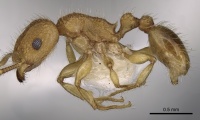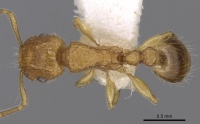Tetramorium obtusidens
| Tetramorium obtusidens | |
|---|---|

| |
| Scientific classification | |
| Kingdom: | Animalia |
| Phylum: | Arthropoda |
| Class: | Insecta |
| Order: | Hymenoptera |
| Family: | Formicidae |
| Subfamily: | Myrmicinae |
| Tribe: | Crematogastrini |
| Genus: | Tetramorium |
| Species: | T. obtusidens |
| Binomial name | |
| Tetramorium obtusidens Viehmeyer, 1916 | |
A specimen was collected from a deciduous forest. Heterick & Kitching (2022) collected this species on tree trunks within a lowland dipterocarp forest in Brunei.
Identification
Distribution
Latitudinal Distribution Pattern
Latitudinal Range: 21.68333333° to -7.966667°.
| North Temperate |
North Subtropical |
Tropical | South Subtropical |
South Temperate |
- Source: AntMaps
Distribution based on Regional Taxon Lists
Indo-Australian Region: Borneo, Brunei Darussalam, Indonesia, Malaysia, Philippines, Singapore (type locality).
Palaearctic Region: China.
Distribution based on AntMaps
Distribution based on AntWeb specimens
Check data from AntWeb
Countries Occupied
| Number of countries occupied by this species based on AntWiki Regional Taxon Lists. In general, fewer countries occupied indicates a narrower range, while more countries indicates a more widespread species. |

|
Estimated Abundance
| Relative abundance based on number of AntMaps records per species (this species within the purple bar). Fewer records (to the left) indicates a less abundant/encountered species while more records (to the right) indicates more abundant/encountered species. |

|
Biology
Castes
Nomenclature
The following information is derived from Barry Bolton's Online Catalogue of the Ants of the World.
- obtusidens. Tetramorium obtusidens Viehmeyer, 1916a: 138, fig. 6 (w.) SINGAPORE. See also: Bolton, 1977: 101; Bolton, 1979: 178.
Unless otherwise noted the text for the remainder of this section is reported from the publication that includes the original description.
Description
Worker
Bolton (1979) - TL 2.4-2.7, HL 0.58-0.64, HW 0.49-0.54, CI 81-85, SL 0.38-0.42, SI 77-80, PW 0.34-0.38, AL 0.68-0.74 (8 measured).
With the general characters of the complex and of the bicarinatum-group to which it belongs, but with additional characters as follows. Frontal carinae less strongly developed than in Tetramorium adelphon or Tetramorium kydelphon, extending back beyond level of eye but weak, scarcely stronger than other cephalic rugulae. Maximum diameter of eye 0'12-0'14, about 0·25-0'27 x HW. Petiole node in dorsal view as broad or slightly broader than long. Dorsum of head irregularly longitudinally rugulose, with a reticulum occipitally. Dorsal alitrunk reticulate-rugulose but without a raised transverse carina at the promesonotal junction. Petiole dorsum with sparse rugulae, postpetiole dorsally with fine superficial punctulation, at most with only one or two very feeble longitudinal marks. Pilosity on dorsal surfaces of head and body much denser than in adelphon or kydelphon, the individual hairs finer and more flexuous than in those species. Colour pale yellow.
Type Material
Bolton (1977) - Syntype females, Singapore: Jurong Road (H. Overbeck) (Berlin Museum für Naturkunde der Humboldt-Universität) [examined].
References
- Bolton, B. 1977. The ant tribe Tetramoriini (Hymenoptera: Formicidae). The genus Tetramorium Mayr in the Oriental and Indo-Australian regions, and in Australia. Bulletin of the British Museum (Natural History). Entomology. 36:67-151. (page 101, see also)
- Bolton, B. 1979. The ant tribe Tetramoriini (Hymenoptera: Formicidae). The genus Tetramorium Mayr in the Malagasy region and in the New World. Bull. Br. Mus. (Nat. Hist.) Entomol. 38: 129-181 (page 178, see also)
- Heterick, B.E., Kitching, R.L. 2022. The ants (Hymenoptera: Formicidae) of a one-hectare plot of lowland dipterocarp forest. Entomologist’s Monthly Magazine 158(4), 261–272 (doi:10.31184/m00138908.1584.4153).
- Khachonpisitsak, S., Yamane, S., Sriwichai, P., Jaitrong, W. 2020. An updated checklist of the ants of Thailand (Hymenoptera, Formicidae). ZooKeys 998, 1–182 (doi:10.3897/zookeys.998.54902).
- Viehmeyer, H. 1916a [1915]. Ameisen von Singapore. Beobachtet und gesammelt von H. Overbeck. Arch. Naturgesch. (A) 81(8): 108-168 (page 138, fig. 6 worker described)
- Wang, W.Y., Soh, E.J.Y., Yong, G.W.J., Wong, M.K.L., Benoit Guénard, Economo, E.P., Yamane, S. 2022. Remarkable diversity in a little red dot: a comprehensive checklist of known ant species in Singapore (Hymenoptera: Formicidae) with notes on ecology and taxonomy. Asian Myrmecology 15: e015006 (doi:10.20362/am.015006).
References based on Global Ant Biodiversity Informatics
- Bolton B. 1977. The ant tribe Tetramoriini (Hymenoptera: Formicidae). The genus Tetramorium Mayr in the Oriental and Indo-Australian regions, and in Australia. Bulletin of the British Museum (Natural History). Entomology 36:67-151.
- Bolton, B. "The ant tribe Tetramoriini (Hymenoptera: Formicinae. The genus Tetramorium Mayr in the Oriental and Indo-Australian regions and in Australia." Bulletin of the British Museum (National History): Entomology series 36, no. 2 (1977): 68-151.
- Floren A., W. Wetzel, and M. Staab. 2013. The contribution of canopy species to overall ant diversity (Hymenoptera: Formicidae) in temperate and tropical ecosystems. Myrmecological News 19: 65-74.
- Fontanilla A. M., A. Nakamura, Z. Xu, M. Cao, R. L. Kitching, Y. Tang, and C. J. Burwell. 2019. Taxonomic and functional ant diversity along tropical, subtropical, and subalpine elevational transects in southwest China. Insects 10, 128; doi:10.3390/insects10050128
- General D. M., and G. D. Alpert. 2012. A synoptic review of the ant genera (Hymenoptera, Formicidae) of the Philippines. Zookeys 200: 1-111.
- Guénard B., and R. R. Dunn. 2012. A checklist of the ants of China. Zootaxa 3558: 1-77.
- Pfeiffer M.; Mezger, D.; Hosoishi, S.; Bakhtiar, E. Y.; Kohout, R. J. 2011. The Formicidae of Borneo (Insecta: Hymenoptera): a preliminary species list. Asian Myrmecology 4:9-58
- Schlick-Steiner B. C.; F.M. Steiner, and H. Zettel. 2006. Tetramorium pacificum Mayr, 1870, T. scabrum Mayr, 1879 sp.rev., T. manobo (Calilung, 2000) (Hymenoptera: Formicidae) three good species. Myrmecologische Nachrichten 8:181-191.
- Xu F. F., and J. Chen. 2009. Comparison of the Differences in Response to the Change of the Extrafloral Nectar-ant-herbivore Interaction System Between a Native and an Introduced Passiflora Species. Acta Botanica Yunnanica 31(6): 543-550.
- Xu Z. 1998. A report of fourty-one ant species newly recorded in China from Xishuangbanna District of Yunnan Province (Hymenoptera: Formicidae). Zhongguo Xue Shu Qi Kan Wen Zhai 4: 1119-1121.

